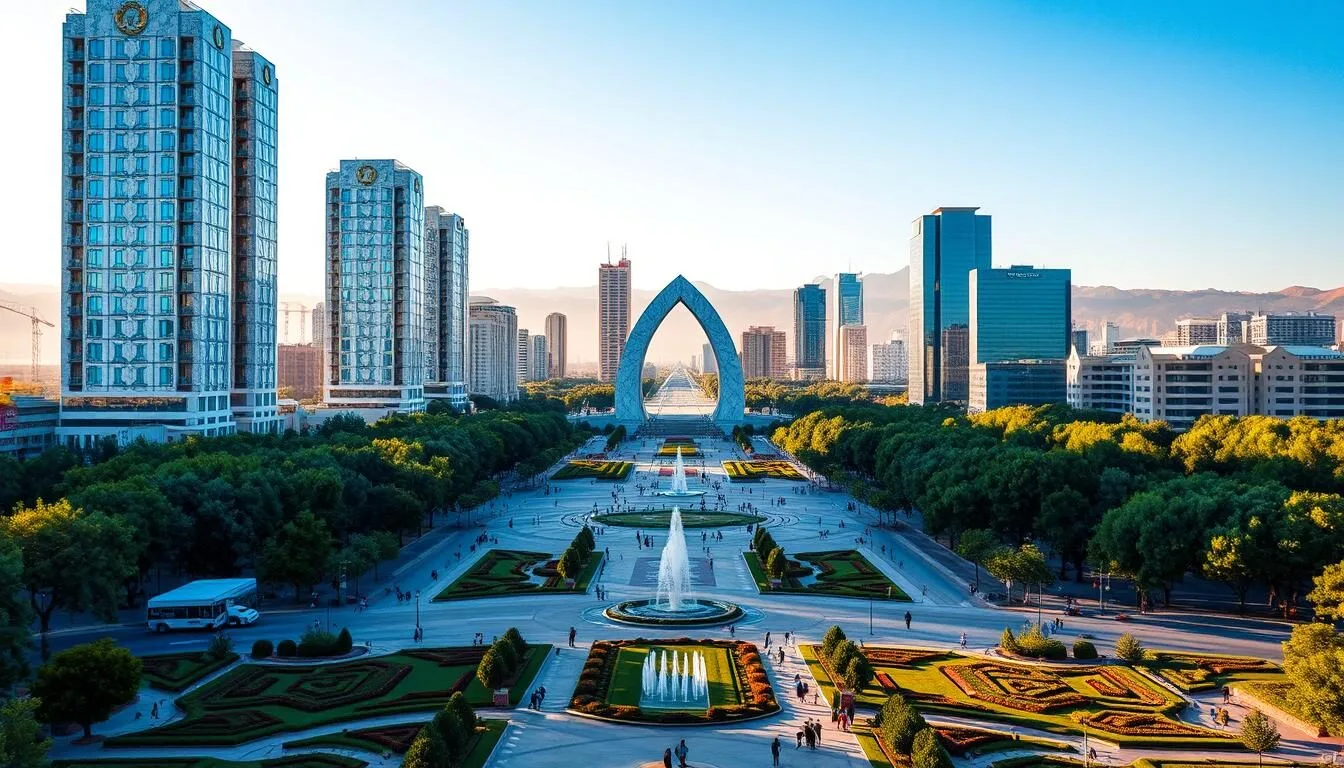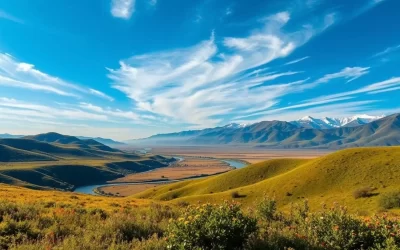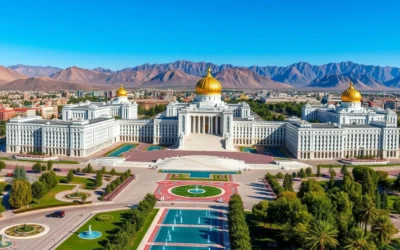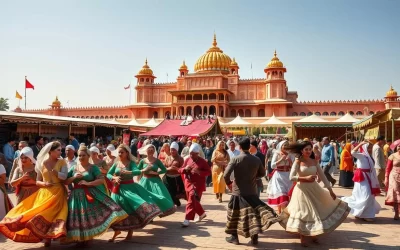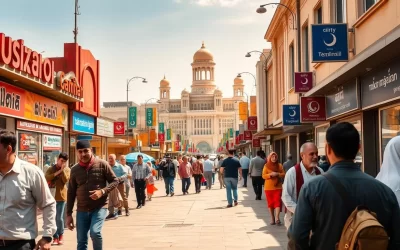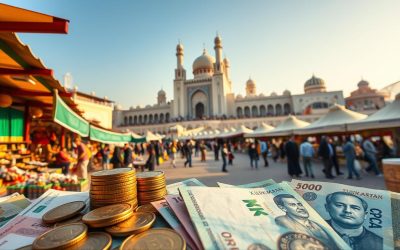Imagine a city that seems like it’s been plucked straight from a futuristic movie set. Ashgabat, the capital of Turkmenistan, is a place where surreal landscapes and monumental architecture converge, creating an otherworldly experience for visitors.
This city is known for its stunning white marble buildings and carefully planned layout, making it a fascinating destination for travelers. As the heart of Central Asia‘s most enigmatic country, Ashgabat offers a unique blend of traditional and modern attractions.
Whether you’re planning a dedicated trip or including this remarkable city as part of a larger Central Asian journey, you’ll need to know what to expect. This guide provides you with everything you need to navigate Ashgabat’s top attractions and make the most of your travel experience.
Discovering Ashgabat: The Marble Marvel of Central Asia
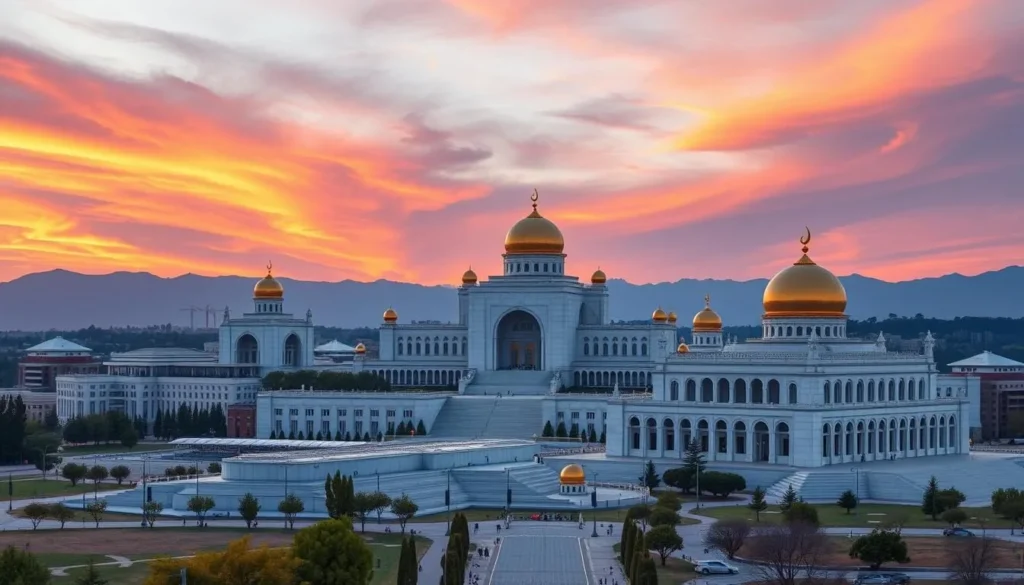
With its gleaming white marble buildings and golden domes, Ashgabat is a city that will transport you to a world unlike any other. As the capital of Turkmenistan, Ashgabat has been crafted into a marvel of modern architecture, blending seamlessly with its rich cultural heritage.
A Brief History of Turkmenistan’s Capital
Ashgabat’s history is as fascinating as it is complex, with roots tracing back to the ancient Silk Road. The city has undergone significant transformations over the years, particularly during the Soviet era and after gaining independence in 1991. Today, Ashgabat stands as a testament to the country’s ambitions, with its grandiose architecture reflecting a mix of traditional Turkmen motifs and modern sensibilities.
Why Ashgabat Should Be on Your Travel Radar
Ashgabat offers a truly unique travel experience, combining surreal architecture, fascinating cultural insights, and the chance to explore one of Central Asia’s least-visited countries. Here are a few reasons why you should consider Ashgabat for your next adventure:
- Ashgabat offers a truly unique travel experience that combines surreal architecture, fascinating cultural insights, and the chance to explore one of Central Asia’s least-visited countries.
- The city’s otherworldly appearance, with its gleaming white marble buildings, golden domes, and immaculately clean streets, creates a visual spectacle unlike anywhere else in the world.
- Despite being relatively unknown to most travelers, Ashgabat provides a safe, clean, and organized place to experience Turkmen culture and hospitality.
- The contrast between the monumental public buildings and everyday life creates a fascinating dynamic that offers photographers and culture enthusiasts endless opportunities.
- Visiting Ashgabat gives you bragging rights to having explored one of the world’s most unusual capital cities, a place that few travelers ever get to experience.
As you explore Ashgabat, you’ll discover that it’s not just the architecture that makes this city special – it’s the blend of tradition, culture, and modernity that makes for a truly unforgettable travel experience.
Best Time to Visit Ashgabat
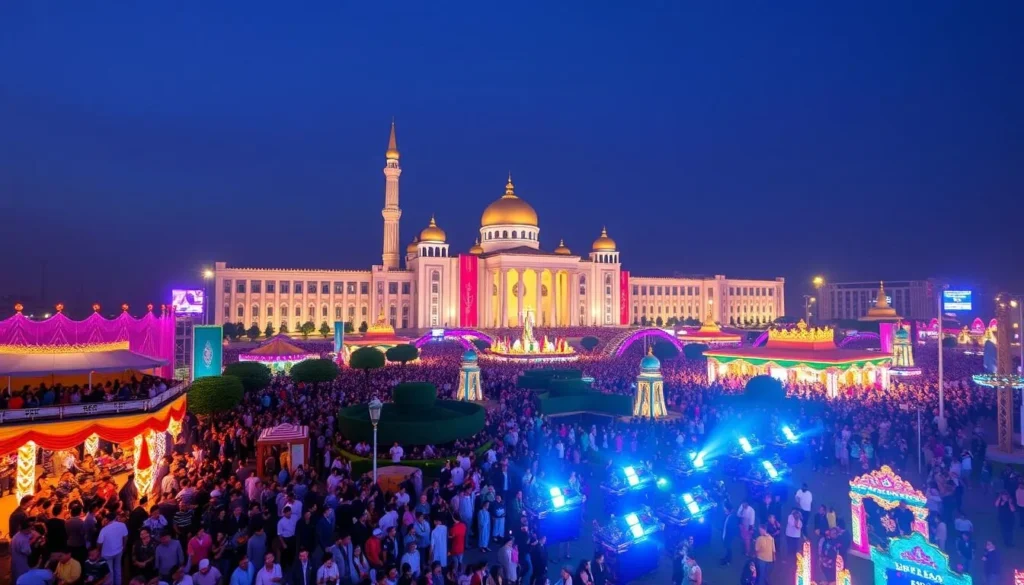
The best time to visit Ashgabat depends on your preferences regarding weather and cultural events. Understanding the seasonal weather patterns and significant cultural festivals will help you plan your trip effectively.
Seasonal Weather Patterns
Ashgabat experiences a continental climate with hot summers and cold winters. The most comfortable time to visit is during spring (April-May) and autumn (September-October), when the temperature is mild and pleasant.
Cultural Events and Festivals Worth Timing Your Visit For
Ashgabat hosts various cultural events throughout the year. Some notable celebrations include:
- Independence Day on September 27th, marked with parades and fireworks.
- Horse Day in April, honoring the Akhal-Teke horses with equestrian displays.
- Melon Day in August, celebrating the country’s prized melons.
- Neutrality Day on December 12th, commemorating Turkmenistan’s neutral status.
- The anniversary of the first president’s birthday on February 19th, marked with cultural performances.
Timing your visit to coincide with these events can enrich your experience of the country’s culture and traditions, making your trip a memorable one.
Practical Travel Information for Visiting Ashgabat

Traveling to Ashgabat involves several logistical considerations, from visa requirements to staying connected during your visit. Ensuring you’re well-prepared will make your trip smoother and more enjoyable.
Visa Requirements and Application Process
Obtaining a visa for Turkmenistan is a necessary step for most travelers. The process typically involves applying through the Turkmenistan embassy or consulate in your home country or using an authorized travel agency that specializes in Turkmenistan tourism. The visa application process can be lengthy, so it’s advisable to start early.
Required documents usually include a valid passport, a completed application form, and sometimes a letter of invitation. The type of visa you need can depend on the purpose of your visit and your nationality.
Currency and Daily Budget Expectations
The local currency is the Turkmenistan manat (TMT). While credit cards are not widely accepted, having some local currency for daily expenses is a good idea. Your daily budget can vary significantly depending on your accommodation choices, dining options, and activities.
Budget-conscious travelers can expect to spend around $30-50 per day, while those opting for more luxury can spend $100 or more. Understanding your budget expectations helps in planning a more enjoyable trip.
Internet Access and Communication Tips
Internet access in Ashgabat is limited and heavily censored. Free WiFi is generally available only in major hotels like the Oguzkent Hotel and Grand Turkmen Hotel.
- Social media platforms and many international news websites are blocked, so installing a VPN service before arrival is essential if you need regular internet access.
- Mobile data is available but is often expensive and slow, making it impractical for anything beyond basic communication.
- International calling rates from Turkmenistan are high, so consider using internet-based calling services when connected to hotel WiFi.
- Local SIM cards can be purchased but require registration with your passport and may not provide reliable service throughout your stay.
To stay connected, consider using internet-based communication services that can be accessed via hotel WiFi, ensuring you stay in touch with family and friends back home or handle any urgent work matters.
Getting Around Ashgabat

Navigating Ashgabat can be a breeze with the right transportation options. As you explore this modern city, you’ll find that getting around is relatively straightforward. The city is designed to be navigable, with wide avenues and significant landmarks making it easy to find your way.
Public Transportation Options
Ashgabat has a range of public transportation options, including buses and potentially other forms of transit. While the city is quite modern and walkable, using public transport can be an efficient way to cover longer distances or reach outlying areas. However, it’s worth noting that the public transportation system might not be as frequent or comprehensive as in larger global cities.
Taxi Services and Negotiating Fares
Taxis are abundant in Ashgabat and provide the most convenient way to navigate the city, especially for longer distances or when carrying luggage. Official taxis are typically white or yellow with a taxi sign, but many unofficial taxis (private cars) also operate and are generally safe to use. Negotiating the fare before entering the taxi is essential, as meters are rarely used, and prices can be inflated for tourists. A typical taxi ride within the city should cost between 10-20 Manat ($3-6), depending on the distance and time of day. Having your destination written in Turkmen or Russian can help overcome language barriers and ensure you reach the correct location without confusion.
When using taxis, be mindful of the price and negotiate the fare in advance to avoid any confusion. This way, you can enjoy the convenience of taxi travel while keeping your expenses in check.
Ashgabat, Turkmenistan: Best Things to Do – Top Picks
Ashgabat, a city of contrasts, where the old meets the new, is a treasure trove of cultural and historical landmarks waiting to be discovered. As you explore this fascinating city, you’ll uncover a blend of modern architecture and ancient traditions that make Ashgabat a unique destination.
Iconic Monuments and Architectural Wonders
Ashgabat is renowned for its stunning monuments and architectural achievements. One of the city’s most iconic landmarks is the Arch of Neutrality, which offers panoramic views of the city from its observation deck. This makes it a must-visit place for photographers and those wanting to appreciate Ashgabat’s unique layout. The Arch is not only an architectural marvel but also a symbol of Turkmenistan’s commitment to neutrality.
Another significant attraction is the ancient settlement of Nisa, located just outside Ashgabat. This UNESCO World Heritage site was once an important center of the Parthian Empire and offers a glimpse into the region’s pre-Islamic history. Visitors can explore the ruins and imagine the historical significance of this ancient city.

Cultural and Historical Attractions
Ashgabat is home to several museums that showcase the rich cultural heritage of Turkmenistan. The National Museum of Turkmenistan houses an impressive collection of artifacts spanning 5,000 years of history, including archaeological treasures from ancient Silk Road cities. This museum is a must-visit for anyone interested in the history and culture of the region.
The Turkmen Carpet Museum is another cultural gem, displaying the world’s largest collection of authentic Turkmen carpets. The museum’s pièce de résistance is a massive 301 square meter handwoven carpet that holds a Guinness World Record. Visitors can marvel at the intricate designs and craftsmanship that go into creating these beautiful carpets.
Additionally, the Museum of Fine Arts showcases an extensive collection of Turkmen art and cultural artifacts, providing visitors with insights into the country’s rich artistic heritage. These museums collectively offer a comprehensive understanding of Turkmenistan’s history, culture, and traditions.
As you explore Ashgabat, you’ll discover that the city’s cultural and historical attractions are not limited to its museums. The city’s layout, with its broad avenues and grandiose buildings, is a testament to its rich history and cultural significance. Whether you’re interested in history, culture, or simply want to experience the unique atmosphere of Ashgabat, this city has something to offer every kind of visitor.
Independence Monument and Independence Park
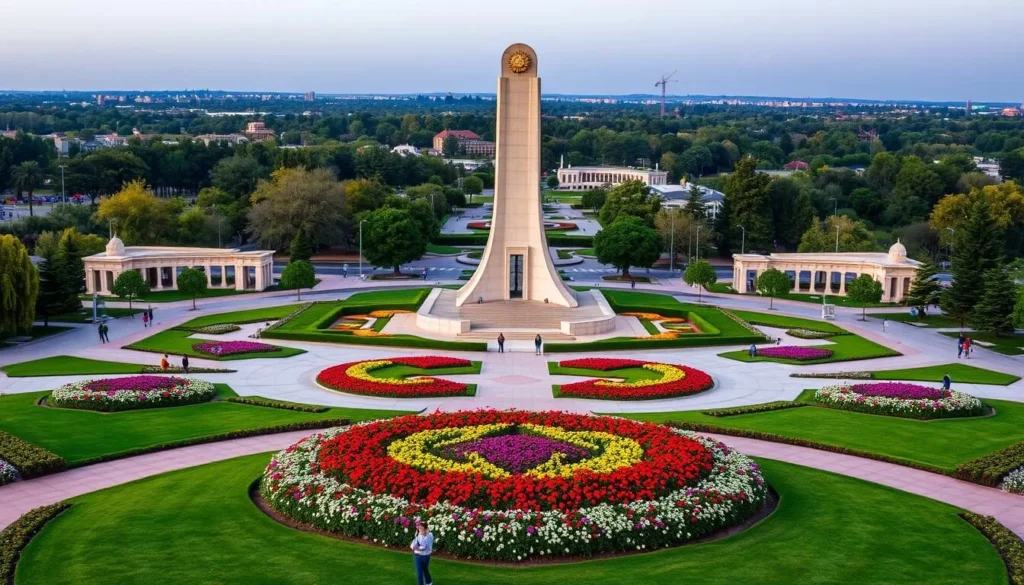
As you explore Ashgabat, you’ll come across the Independence Monument, a striking landmark that embodies the nation’s spirit. This monument is not just a symbol of Turkmenistan’s independence; it’s a place where visitors can connect with the country’s rich history.
The Symbolism Behind the Monument
The Independence Monument is steeped in symbolism, representing the country’s struggle for and achievement of independence. It’s an area where national pride is palpable, and the monument’s design reflects the unique cultural and historical context of Turkmenistan.
What to See in the Surrounding Park
Independence Park surrounds the monument, offering beautifully landscaped gardens, fountains, and walking paths that make it a pleasant place for both visitors and locals. Some of the key features include:
- Independence Park surrounds the monument with beautifully landscaped gardens, fountains, and walking paths that make it a pleasant place for both visitors and locals.
- The park features miniature replicas of other significant buildings in Turkmenistan, creating a unique architectural showcase of the country’s most famous structures.
- A massive flagpole in the park flies one of the world’s largest national flags, visible from most areas of the city and especially impressive when caught in the wind.
- The park’s central fountain display is choreographed to music at certain times, creating a mesmerizing water show that’s particularly beautiful when illuminated at night.
- Numerous smaller monuments and sculptures throughout the area tell additional stories from Turkmen history and culture, making a stroll through the entire park educational as well as scenic.
Neutrality Monument: Ashgabat’s Golden Icon
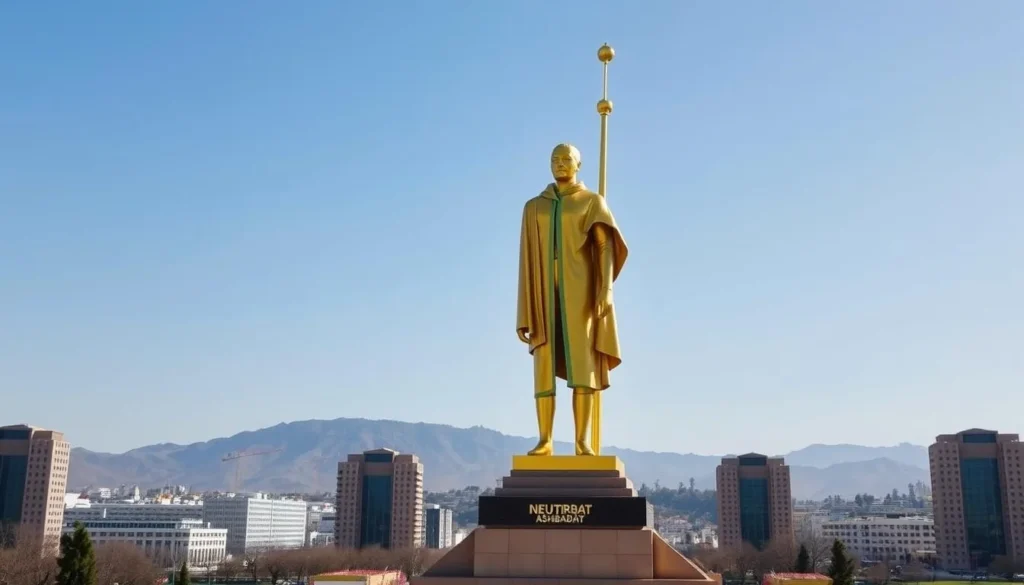
The Neutrality Monument stands as a gleaming testament to Ashgabat’s architectural prowess. This iconic landmark is a must-visit attraction for anyone traveling to the city.
The Rotating Golden Statue
The Neutrality Monument is crowned with a rotating golden statue, symbolizing Turkmenistan’s commitment to neutrality. This striking feature is not only visually stunning but also holds significant cultural and political importance. As the statue rotates, it reflects the changing light, creating a mesmerizing spectacle.
Panoramic Views from the Observation Deck
The monument features an observation deck that offers visitors spectacular 360-degree panoramic views of Ashgabat and the surrounding area. Accessible via an elevator inside one of the monument’s legs, the viewing platform provides the best vantage point to appreciate the city’s unique urban planning and architecture. From this height, you can clearly see the stark contrast between the gleaming white government buildings and the more traditional residential areas of the city. The observation deck is particularly impressive at sunset when the city’s white marble buildings take on golden hues in the fading light. Photographers will find endless opportunities to capture unique perspectives of Ashgabat’s skyline, with the Kopet Dag mountains providing a dramatic backdrop to the south.
Exploring the Turkmen Carpet Museum
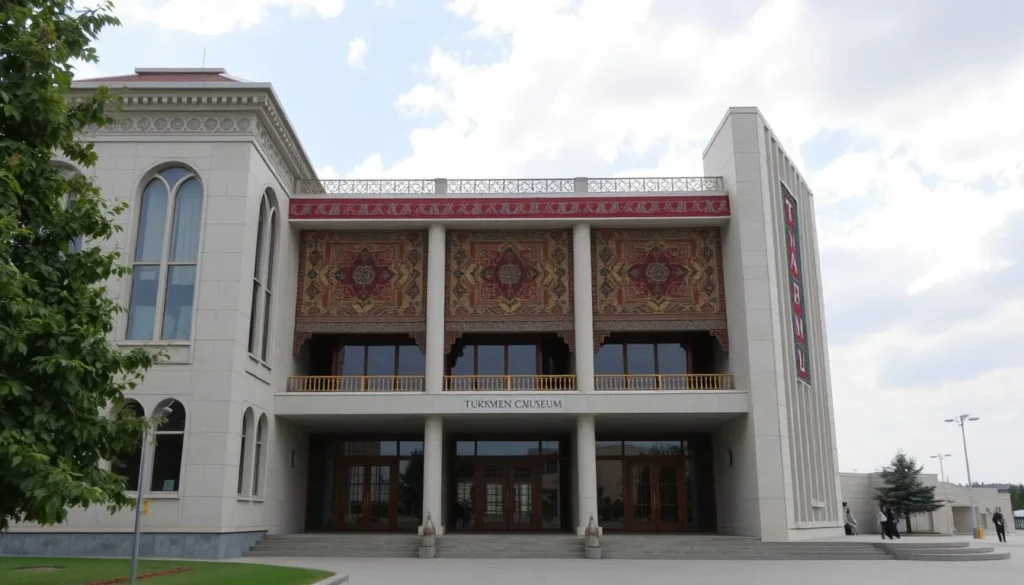
Visitors to Ashgabat can experience the essence of Turkmenistan’s cultural identity at the Turkmen Carpet Museum. This museum is a treasure trove of the country’s rich heritage, featuring an extensive collection of Turkmen carpets that date back centuries.
The World’s Largest Collection of Turkmen Carpets
The Turkmen Carpet Museum is home to the world’s largest collection of Turkmen carpets, with pieces that exemplify the artistry and craftsmanship of Turkmen weavers. The museum’s collection includes carpets of various sizes and designs, each telling a story about the country’s history and cultural traditions.
Some of the carpets on display are centuries old, while others are contemporary pieces that continue the traditional techniques passed down through generations. The intricate designs often reflect scenes from everyday life, as well as mythological and symbolic motifs.
Understanding the Cultural Significance of Carpet Weaving
Carpet weaving in Turkmenistan is more than a craft; it’s an ancient art form that has been passed down through generations. The museum explains how carpet motifs reflect the country’s complex cultural history, showing influences from various civilizations along the Silk Road while maintaining distinctly Turkmen characteristics.
- Carpet weaving serves as a visual language expressing tribal identity and history.
- Traditional Turkmen carpets feature distinctive patterns that identify the specific tribe or region they come from.
- Carpets served multiple purposes in nomadic Turkmen society, including as valuable trade goods along the Silk Road.
- The museum showcases how carpet weaving remains a living tradition and source of national pride.
- Today, Turkmenistan actively works to preserve traditional techniques while adapting to contemporary markets.
By exploring the Turkmen Carpet Museum, visitors can gain a deeper understanding of the significance of carpet weaving in Turkmen culture and its role in reflecting the life and traditions of the Turkmen people.
Wedding Palace (Bagt köşgi): A Unique Architectural Marvel
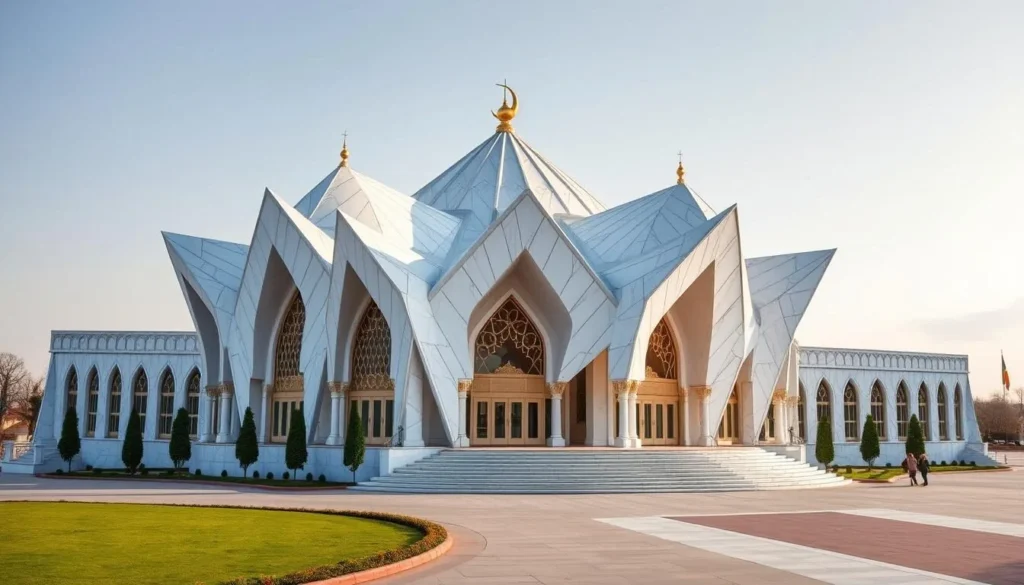
The Wedding Palace, or Bagt köşgi, is a must-see attraction in Ashgabat. This stunning building is not only a popular venue for weddings but also a significant architectural landmark that showcases the city’s modern design sensibilities.
The Star-Shaped Design and Its Meaning
The Wedding Palace is renowned for its striking star-shaped design, which symbolizes the country’s rich cultural heritage and its aspirations for a bright future. The building’s architecture is a blend of traditional Turkmen motifs and contemporary styles, making it a fascinating subject for both locals and visitors to admire.
Visitor Information and Photography Tips
When planning your time to visit the Wedding Palace, note that it is open to visitors even when weddings are not taking place, although the hours may vary. It’s advisable to visit with a guide who can arrange proper access. Photography is permitted outside and in certain interior areas, making it a photographer’s delight. The best time for exterior photography is in the late afternoon when the setting sun casts a golden glow on the building’s western face.
Visitors can sometimes observe traditional Turkmen wedding ceremonies if they time their visit appropriately, offering a glimpse into local customs. The upper floors provide excellent views of the city, though access may be restricted during official activities.
Turkmen Museum of Fine Arts: A Cultural Treasure Trove
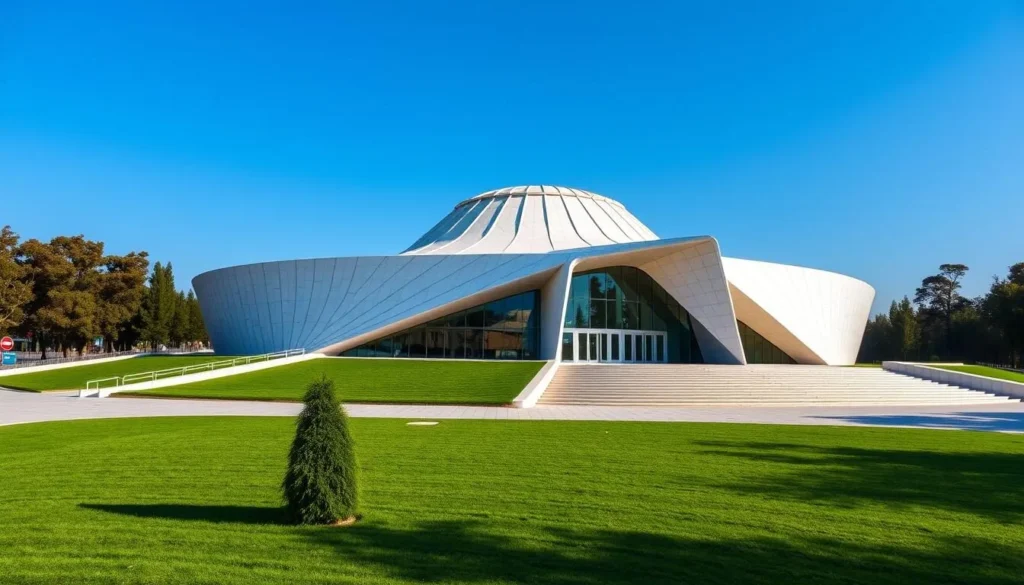
The Turkmen Museum of Fine Arts is a cultural treasure trove in Ashgabat, offering a glimpse into the country’s rich artistic heritage. With its impressive collection, the museum is a must-visit destination for art enthusiasts.
Notable Collections and Exhibits
The Turkmen Museum of Fine Arts boasts an extensive collection of artworks that reflect the country’s history and cultural identity. You can explore a diverse range of exhibits, including traditional Turkmen crafts, paintings, and sculptures. The museum’s collection provides valuable insights into the country’s artistic traditions and its people’s way of life.
Some of the notable exhibits include intricate carpet weavings, ornate jewelry, and ceremonial costumes, all of which demonstrate the exceptional craftsmanship of Turkmen artisans. As you take your time to appreciate these exhibits, you will gain a deeper understanding of the cultural significance of these art forms.
Practical Visitor Information
To make the most of your visit to the Turkmen Museum of Fine Arts, it’s essential to plan ahead. The museum is typically open from 9:00 AM to 5:00 PM, Tuesday through Sunday, with Monday being a regular closing day for maintenance. Visitors can expect to spend around 1-2 hours exploring the exhibits, depending on their level of interest.
- The museum is typically open from 9:00 AM to 5:00 PM Tuesday through Sunday.
- Entrance fees are modest, approximately $2-3 for foreigners.
- Photography is permitted in most areas for an additional fee.
- English-speaking guides can be arranged in advance through your hotel or tour service.
- The museum gift shop offers high-quality reproductions and books about Turkmen art.
By utilizing the service of an English-speaking guide, you can enhance your overall experience and gain a deeper appreciation for the museum’s collections.
Shopping and Local Culture at Altyn Asyr Bazaar
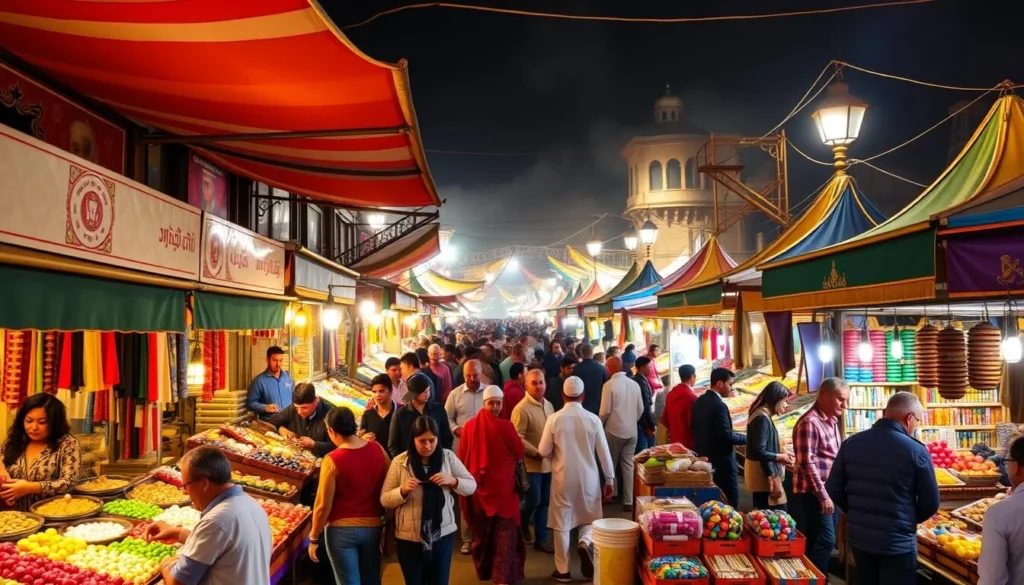
The bustling Altyn Asyr Bazaar offers a unique shopping experience in the heart of Ashgabat. As you navigate through the stalls, you’ll be immersed in the local culture and daily life of the Turkmen people.
What to Buy: Souvenirs and Local Crafts
Altyn Asyr Bazaar is a treasure trove for souvenir hunters and those interested in local crafts. You can find a variety of goods, including traditional Turkmen textiles, handmade jewelry, and intricately designed ceramics. When shopping, remember that bargaining is expected for most items. Start by offering about 60-70% of the initial asking price and work your way to a mutually acceptable figure.
The bazaar is organized into distinct sections, making it easier to find what you’re looking for. From textiles and souvenirs to local produce and household goods, each category has its designated area.
Navigating the Market Like a Local
To make the most of your visit, plan to arrive during the morning hours (8:00-11:00 AM) when the bazaar is less crowded, and vendors are eager to make their first sales. Don’t miss the opportunity to sample local specialties like chorba (soup), plov (rice pilaf), and various breads and pastries at very reasonable prices in the food section.
It’s also important to dress modestly when visiting the bazaar to show respect for locals and avoid unwanted attention. Ensure your shoulders are covered, and wear pants or skirts that fall below the knee.
Russian Bazaar: Experiencing Local Life
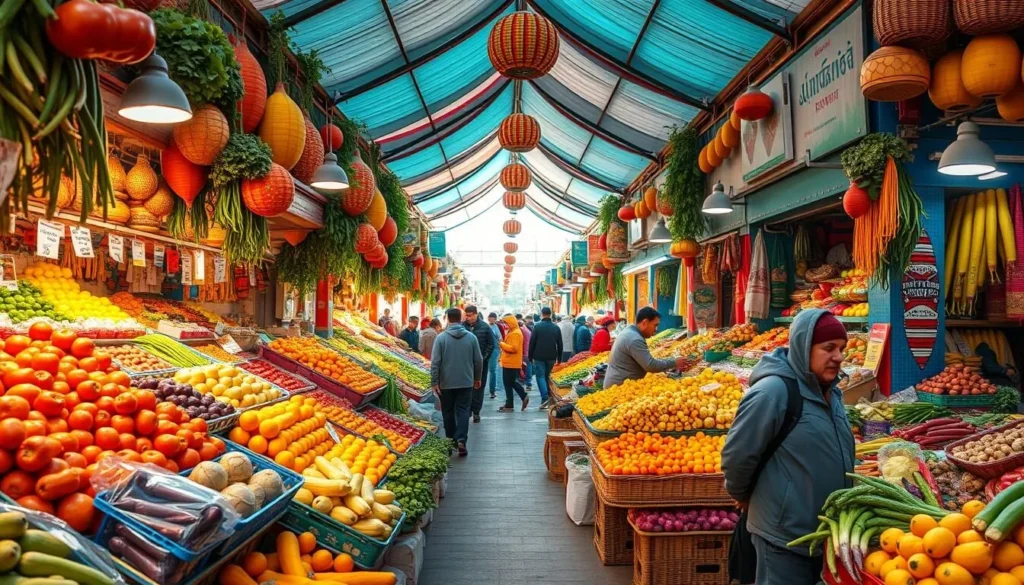
For a genuine taste of Ashgabat’s local life, head to the Russian Bazaar, a hub of activity and color. This bustling marketplace is where locals gather to buy fresh produce, clothing, and household items, offering visitors a unique glimpse into everyday life.
Food and Produce at the Market
The Russian Bazaar is renowned for its diverse array of fresh produce, including exotic fruits, vegetables, and nuts. You can sample local delicacies such as dried apricots, plums, and honey, or purchase ingredients to prepare your own traditional Turkmen dishes.
Photography Restrictions and Etiquette
When taking photos at the Russian Bazaar, be mindful of the stricter photography restrictions due to its proximity to government buildings. Always ask permission before taking pictures of vendors or their goods. Security guards are present throughout the market and may request that you delete photos taken in prohibited areas.
The best time for photography is during the morning hours when the market is bustling and the light is optimal. Be respectful of vendors and follow any instructions from security personnel to ensure a smooth and enjoyable experience.
Gypjak Mosque and Mausoleum: Spiritual Grandeur
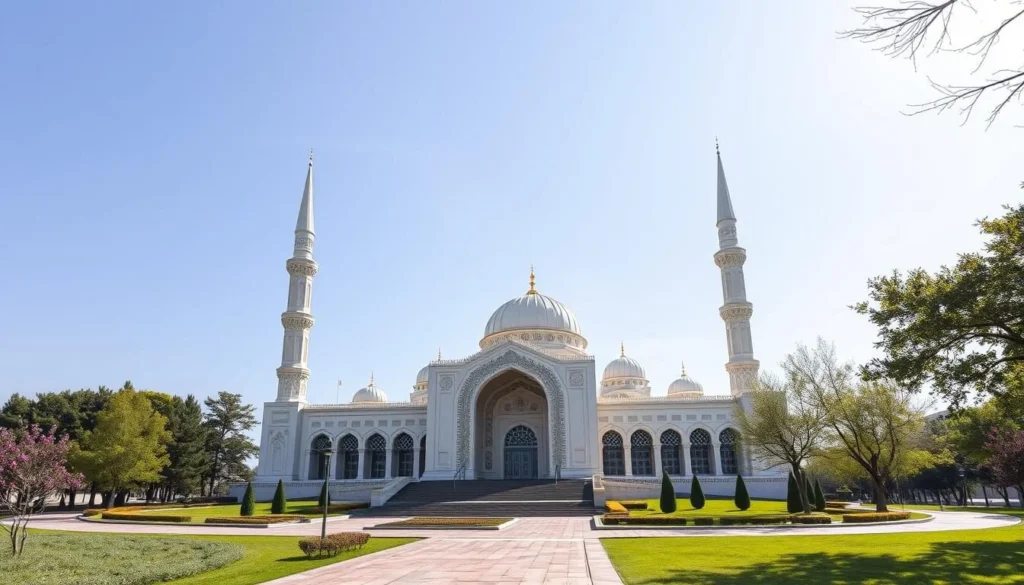
Visitors to Ashgabat can experience the tranquility of the Gypjak Mosque and Mausoleum, a sacred site that embodies the city’s spiritual essence. This complex is not only a place of worship but also a significant cultural landmark that reflects the rich heritage of Turkmenistan.
Architectural Features and Religious Significance
The Gypjak Mosque is renowned for its stunning architecture, which combines traditional Islamic elements with modern design principles. The mosque’s design is characterized by its elegant minarets and a large dome that symbolizes the unity of the Turkmen people. The adjacent mausoleum, where the first president of Turkmenistan is buried, adds to the complex’s religious and historical significance.
Architectural Highlights: The mosque’s intricate tile work and calligraphy are exemplary of Turkmen craftsmanship. The complex’s layout is designed to facilitate both worship and reflection, creating a serene atmosphere for visitors and worshippers alike.
Visitor Etiquette and Dress Code
When visiting the Gypjak Mosque and Mausoleum, it’s essential to respect the local customs and traditions. Here are some guidelines to follow:
- Remove your shoes before entering the mosque; dedicated shoe storage areas are provided.
- Women should cover their hair, arms, and legs; scarves are sometimes available to borrow.
- Men are advised to wear long pants and shirts with sleeves.
- Non-Muslim visitors are welcome outside of prayer times, especially avoiding Friday midday prayers.
- Photography is permitted but should be done discreetly, particularly near the mausoleum.
By dressing modestly and being mindful of prayer times, visitors can ensure a respectful and enriching experience at this sacred site.
Day Trips from Ashgabat
If you’re looking to venture beyond Ashgabat, you’ll find a mix of ancient ruins and breathtaking landscapes just a short drive away. The city serves as a convenient base for exploring the surrounding region, which is rich in history and natural beauty.
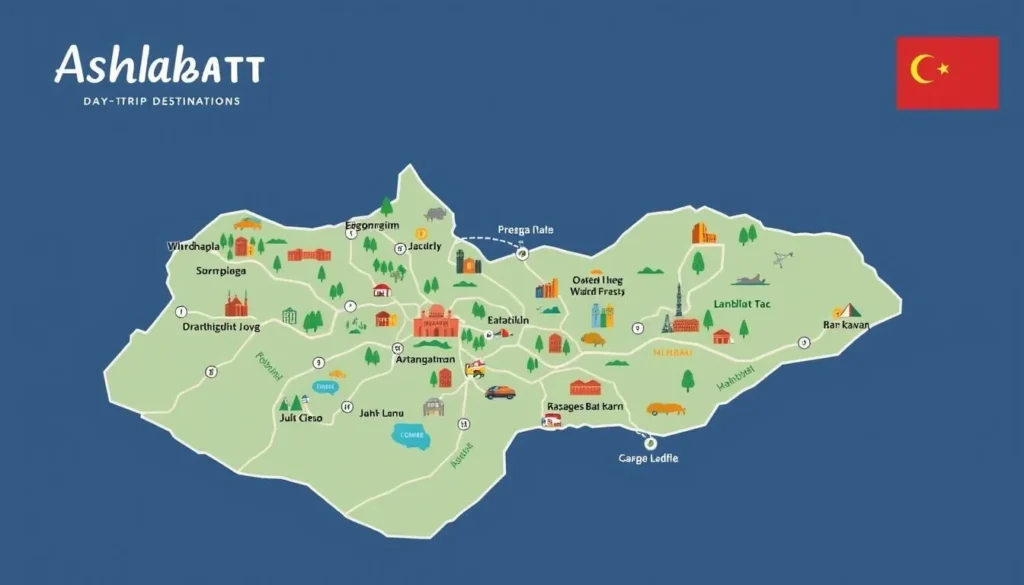
Ancient Nisa: UNESCO World Heritage Site
One of the most significant day trips from Ashgabat is to the ancient city of Nisa, a UNESCO World Heritage Site. This historical site is a must-visit for anyone interested in archaeology and the ancient civilizations of the region. Nisa was once the capital of the Parthian Empire and features a mix of Greek and Persian architectural styles.
The site includes the remains of fortresses, temples, and royal palaces, providing a glimpse into the lives of the people who lived there centuries ago. As you explore Nisa, you’ll be struck by the historical significance and the stunning views of the surrounding landscape.
Kopet Dag Mountains: Natural Beauty Near the City
The Kopet Dag mountains form a natural border between Turkmenistan and Iran, offering spectacular landscapes and hiking opportunities just a short drive from Ashgabat. The Firjuza Gorge, about 30 kilometers from the city, is a popular recreational area featuring a small river, lush vegetation, and cooler temperatures that provide welcome relief during hot summer days.
- The Kopet Dag mountains offer spectacular landscapes and hiking opportunities.
- The Firjuza Gorge is a popular recreational area with a small river and lush vegetation.
- Several hiking trails of varying difficulty wind through the mountains.
- Wildlife enthusiasts might spot native species like the Turkmen wild goat and various birds of prey.
- For a memorable experience, consider timing your visit to catch the sunset over the mountains.
As you explore the Kopet Dag mountains, you’ll be treated to stunning views and the chance to experience the natural beauty of the region. Whether you’re hiking or simply taking in the views, the area around Ashgabat offers a unique day trip experience.
Where to Stay in Ashgabat
When planning your trip to Ashgabat, Turkmenistan, choosing the right hotel can significantly enhance your travel experience. The city offers a variety of accommodations to suit different budgets and preferences.
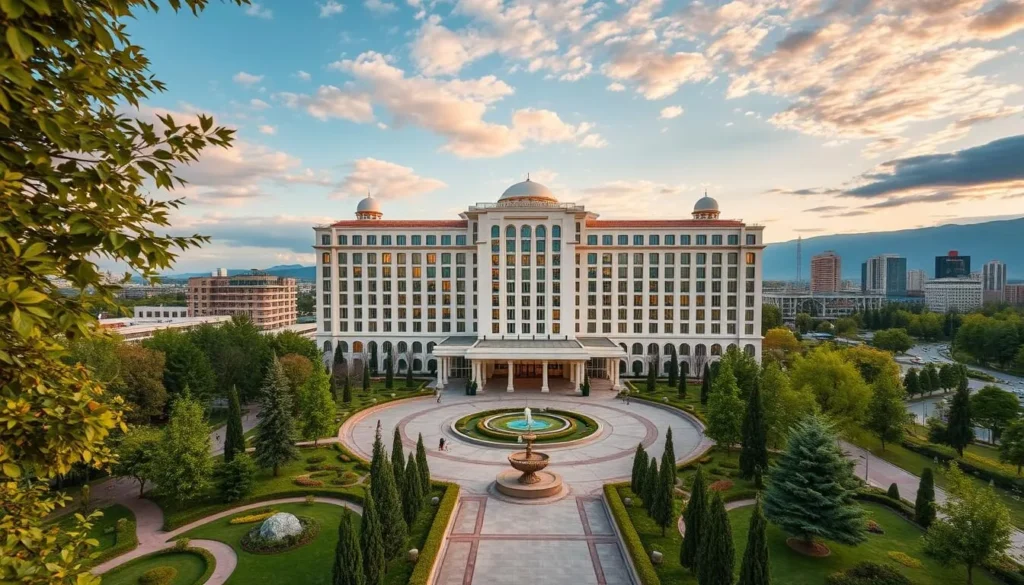
Luxury Accommodations
For travelers seeking a luxurious stay, Ashgabat has several high-end hotels that offer top-notch service and amenities. Although specific luxury hotels are not detailed in the provided information, one can expect high standards of comfort and service.
Mid-Range and Budget Options
For those on a more modest budget, hotels like The Grand Turkmen Hotel offer comfortable accommodations at a moderate price point, approximately $80-120 per night, with clean rooms, reliable hot water, and a central location. Hotel Ak Altyn is another good mid-range option, providing decent amenities, including an on-site restaurant serving international and Turkmen cuisine, at prices ranging from $70-100 per night.
The Sport Hotel, despite its name, caters to all travelers and offers affordable proper hotel rooms in Ashgabat, with basic but clean accommodations starting around $50-60 per night. When booking lower-priced hotels, be aware that service standards may vary, and amenities like reliable WiFi or English-speaking staff are not guaranteed.
Conclusion: Making the Most of Your Ashgabat Adventure
With its unique blend of history and futuristic architecture, Ashgabat is a destination that will leave you in awe. As you conclude your journey through this fascinating city, you’ll find that Ashgabat offers a truly unique travel experience that rewards those willing to navigate the complexities of visiting Turkmenistan with unforgettable sights and cultural insights.
To fully appreciate Ashgabat’s architectural wonders, museums, and bazaars, plan to spend at least 3-4 days in the capital city. Consider splitting your time between structured tour activities during the day and independent exploration in the evening to experience different aspects of city life. This will allow you to witness the city’s transformation at night when buildings are illuminated with colorful LED displays, making evening walks or drives through the central districts a must-do activity.
Don’t miss the opportunity to visit at least one bazaar to sample local food and observe everyday life. Be flexible with your expectations and itinerary, as things don’t always run according to schedule. Take advantage of your hotel’s service desk or your tour guide to navigate any unexpected challenges. Balance your time between the monumental architecture and the more intimate experiences found in restaurants, tea houses, and parks.
Remember, Ashgabat is just one facet of Turkmenistan. If time permits, try to include day trips to places like Nisa or the Kopet Dag mountains for a more complete experience. Despite the challenges, Ashgabat remains a great place for adventurous travelers seeking something truly different from the usual tourist destinations.
The above is subject to change.
Check back often to TRAVEL.COM for the latest travel tips and deals.
